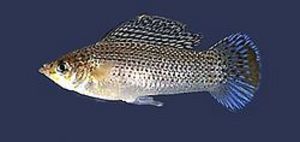Mollies or Poecilla fish are peaceful, attractive tropical fish that thrive on almost any type of fish food presented to them. There are many species, colors and fin lengths of mollies. They get along best with other mollies, especially those of the same species. They get along with many other species of tropical fish such as tetras, danios and platys. They also breed very easily, even in a home aquarium. This can be an advantage or disadvantage, depending on your point of view. With luck, a molly can live up to five years.
Popular Species
Perhaps the most familiar species of pet molly is the Black Molly (Poecilla sphenops.) It basically looks like a black platy. There are several variations of this basic molly patterns, including marble mollies, silver mollies and white mollies.
The sailfin molly group is aptly named, because they have a dramatic sail-shaped fin atop a basic molly body. The main species this group derives from is Poecilla latipinna, according to “Freshwater Aquariums For Dummies;” (Wiley Publishing; 2006.) Some sailfin mollies also have dramatic lyre-shaped tails.
The balloon-bellied molly group is also aptly named, because they all look as if they are heavily pregnant. This can make trying to determine if a female is about to give birth a little difficult, but she should be exhibiting gravid spots, similar to egg-laying fish that are just about to lay.
Birth
Unlike most other species of fish, mollies are livebearers, meaning they give birth to tiny baby fish, or fry instead of laying eggs. The advantage to giving birth means that the fish are far more developed and able to escape from predators than those fry hatched from eggs. Depending on the species, molly gestation lasts around one to two months, although she may not begin to show until a few days before birth.
Depending on the size and health of the mother, mollies can give birth to anywhere from one to 200 fry. First time molly mothers tend to have much smaller broods of around 15 than more experienced mothers. Depending on the species, fry will grow to adult size anywhere from one to 12 months, but they are usually sold to pet stores at six months of age.
Fresh or Brackish?
It seems that there are as many fish experts that claim mollies are freshwater fish as there are those that claim they are brackish waster fish. Wild types do tend to live in freshwater streams. Many pet mollies are hybrids of the wild types. However, pet mollies do well in both freshwater or water with some aquarium salt added. Mollies seem to be incredibly adaptable fish, eating just about anything to living in both types of water.
Freshwater and Marine Aquarium Magazine theorizes that mollies do best in harder water and that salt has nothing to do with it. They conclude that freshwater is best for most mollies with the notable exception of the Peacock Molly (Poecilla picta), but it is vital to do a partial water change at least once a week, no matter what the species.
References:
“Freshwater Aquariums For Dummies.” Maddy Hargrove & Mic Hargrove. Wiley Publishing; 2006.
Freshwater and Marine Aquarium Magazine. “The Great Molly Salt Debate.” http://www.afae.it/pages/tematica/articolipoecilidi/The_great_molly%20salt_debate.htm
Pet Education. “Freshwater Mollies.” http://www.peteducation.com/category.cfm?c=16+1911+1958
Wikipedia. “Poecilla.” http://en.wikipedia.org/wiki/Mollies





